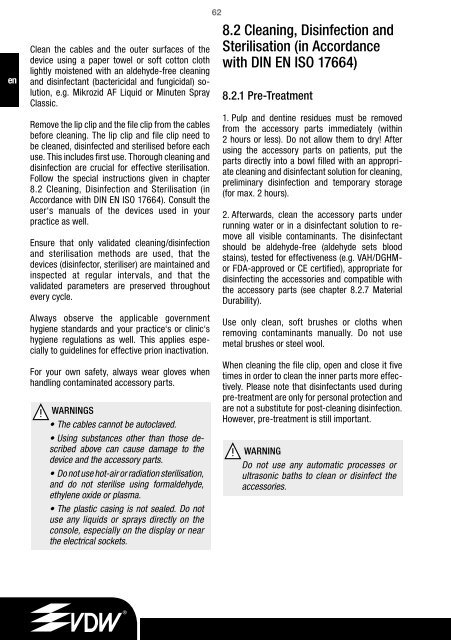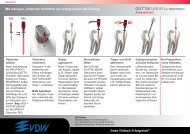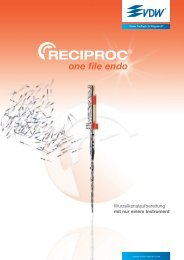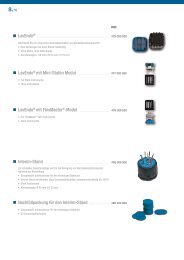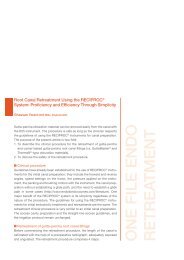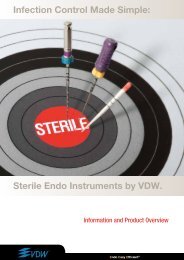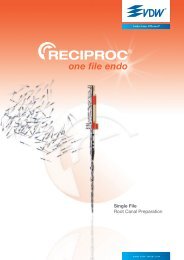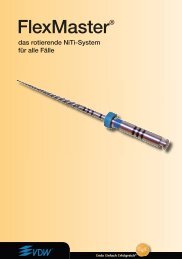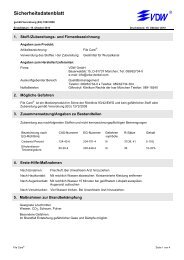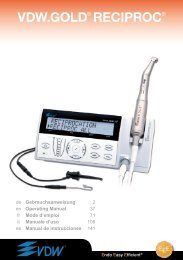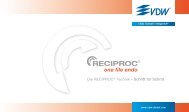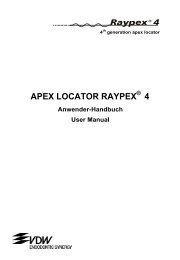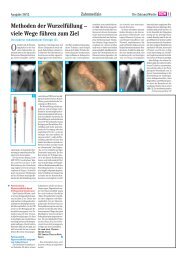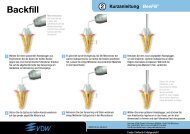RECIPROC® UPGRADE - Vdw-dental.com
RECIPROC® UPGRADE - Vdw-dental.com
RECIPROC® UPGRADE - Vdw-dental.com
You also want an ePaper? Increase the reach of your titles
YUMPU automatically turns print PDFs into web optimized ePapers that Google loves.
en<br />
Clean the cables and the outer surfaces of the<br />
device using a paper towel or soft cotton cloth<br />
lightly moistened with an aldehyde-free cleaning<br />
and disinfectant (bactericidal and fungicidal) solution,<br />
e.g. Mikrozid AF Liquid or Minuten Spray<br />
Classic.<br />
Remove the lip clip and the file clip from the cables<br />
before cleaning. The lip clip and file clip need to<br />
be cleaned, disinfected and sterilised before each<br />
use. This includes first use. Thorough cleaning and<br />
disinfection are crucial for effective sterilisation.<br />
Follow the special instructions given in chapter<br />
8.2 Cleaning, Disinfection and Sterilisation (in<br />
Accordance with DIN EN ISO 17664). Consult the<br />
user‘s manuals of the devices used in your<br />
practice as well.<br />
Ensure that only validated cleaning/disinfection<br />
and sterilisation methods are used, that the<br />
devices (disinfector, steriliser) are maintained and<br />
inspected at regular intervals, and that the<br />
validated parameters are preserved throughout<br />
every cycle.<br />
62<br />
8.2 Cleaning, Disinfection and<br />
Sterilisation (in Accordance<br />
with DIN EN ISO 17664)<br />
8.2.1 Pre-Treatment<br />
1. Pulp and dentine residues must be removed<br />
from the accessory parts immediately (within<br />
2 hours or less). Do not allow them to dry! After<br />
using the accessory parts on patients, put the<br />
parts directly into a bowl filled with an appropriate<br />
cleaning and disinfectant solution for cleaning,<br />
preliminary disinfection and temporary storage<br />
(for max. 2 hours).<br />
2. Afterwards, clean the accessory parts under<br />
running water or in a disinfectant solution to remove<br />
all visible contaminants. The disinfectant<br />
should be aldehyde-free (aldehyde sets blood<br />
stains), tested for effectiveness (e.g. VAH/DGHMor<br />
FDA-approved or CE certified), appropriate for<br />
disinfecting the accessories and <strong>com</strong>patible with<br />
the accessory parts (see chapter 8.2.7 Material<br />
Durability).<br />
Always observe the applicable government<br />
hygiene standards and your practice‘s or clinic‘s<br />
hygiene regulations as well. This applies especially<br />
to guidelines for effective prion inactivation.<br />
For your own safety, always wear gloves when<br />
handling contaminated accessory parts.<br />
WARNINGS<br />
• The cables cannot be autoclaved.<br />
• Using substances other than those described<br />
above can cause damage to the<br />
device and the accessory parts.<br />
• Do not use hot-air or radiation sterilisation,<br />
and do not sterilise using formaldehyde,<br />
ethylene oxide or plasma.<br />
• The plastic casing is not sealed. Do not<br />
use any liquids or sprays directly on the<br />
console, especially on the display or near<br />
the electrical sockets.<br />
Use only clean, soft brushes or cloths when<br />
removing contaminants manually. Do not use<br />
metal brushes or steel wool.<br />
When cleaning the file clip, open and close it five<br />
times in order to clean the inner parts more effectively.<br />
Please note that disinfectants used during<br />
pre-treatment are only for personal protection and<br />
are not a substitute for post-cleaning disinfection.<br />
However, pre-treatment is still important.<br />
WARNING<br />
Do not use any automatic processes or<br />
ultrasonic baths to clean or disinfect the<br />
accessories.


